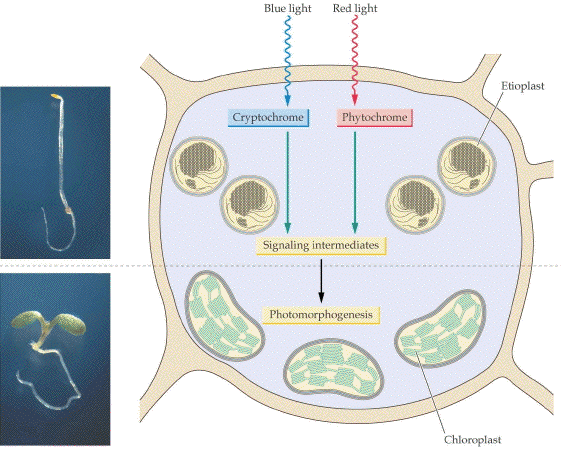Phototropism is directional growth in which the direction of growth is determined by the direction of the light source. In other words, it is the growth and response to a light stimulus. Phototropism is most often observed in plants, but can also occur in other organisms such as fungi. The cells on the plant that are farthest from the light have a chemical called auxin that reacts when phototropism occurs. This causes the plant to have elongated cells on the farthest side from the light. Phototropism is one of the many plant
tropisms or movements which respond to external stimuli. Growth towards a light source is a
positive phototropism, while growth away from light is called
negative phototropism (or
Skototropism). Most plant shoots exhibit positive phototropism, while roots usually exhibit negative phototropism, although
gravitropism may play a larger role in root behavior and growth. Some vine shoot tips exhibit negative phototropism, which allows them to grow towards dark, solid objects and climb them.
.
Plants absorb light with the help of
chlorophyll that is built into the thylakoids' membranes. This chlorophyll is green in colour and absorbs red and blue light. They do not and are incapable of absorbing green light. It is this fact, the inability to absorb green light, that makes the leaves of
plants and chlorophyll appear green to the human eye. Plants require light energy for the process of Photosynthesis by which they convert this light energy to chemical energy. This energy is stored by plants in bonds of sugar. The process of converting light energy into a food source is unique to plants and some algae. No other type of organisms on earth can manufacture its own food. The
chemical reaction that takes place during this process is represented as 6CO2 + 6H2O (+ light energy) → C6H12O6 + 6O2.
.
BASIC PHOTOMORPHOGENESIS
James Shinkle
Department of Biology, Trinity University
San Antonio, TX 78212-7200
[email protected]
Introduction
Big sessile organisms like plants and fungi and small organisms whose motility can't move them that far, like bacteria and protists, have no option but to function in the environment they are found in. For photosynthetic organisms it has been adaptive for them to develop mechanisms to sense their light environment, and adjust their form and metabolism to optimize their performance under their local conditions. Since light environments change, these organisms have also developed the ability to continuously adjust their function to current conditions. Taken together these responses to light constitute the phenomenon known as photomorphogenesis.
The definition of photomorphogenesis, as applied in this module, is any change in form or function of an organism occurring in response to changes in the light environment. Photomorphogenesis is often defined as light-regulated plant development (Figure 1), but there are also changes in morphology and/or cell structure and function, which occur as transient acclimatizations to a changing environment, which are also light regulated. Particularly if this more inclusive definition is used, photomorphogenesis is a process common to organisms well beyond the plant kingdom. While there may be only a few examples of photomorphogenesis in the animal kingdom, it is a common feature of development in fungi, protists, and bacteria, as well as plants. While this module will focus on what is known from studies of plant photomorphogenesis, there will be selected examples from other kingdoms.
Figure 1. Photomorphogenesis as a morphological and as a cellular process. The left photos show the change in form of an
Arabidopsis thaliana seedling grown in darkness (top) or in white light. The right hand illustration shows the change in chloroplast structure and diagrams the progress of light signals through two receptor systems, cryptochrome and phytochrome. Adapted from Biochemistry and Molecular Biology of Plants, (c) American Society of Plant Biologists, with permission.
The Information Content Of Light
Photomorphogenesis is an organismal response to information present in the light environment. There is information concerning: simple presence of light, light direction, light intensity, light duration, spectral quality and polarization (see Mougeotia: A Chloroplast with a Twist, for a description of the last phenomenon). Studies have demonstrated photomorphogenic effects of all of these parameters of the light environment in diverse organisms. However, it must be acknowledged that the responses to polarization were observed in laboratory conditions that may not have any parallel in the natural light environment. It should also be noted that the earliest responses to light exhibited by germinating seedlings are initiated by the mere presence (or absence) of light, information of the simplest sort possible.
Diversity Of Processes Of Photomorphogenesis
It would be impossible to provide a comprehensive catalog of photomorphogenic processes, and it would not serve any particularly useful purpose. The brief list below is an illustration of the diversity of organisms and processes falling within the realm of photomorphogenesis. All of the processes listed entail the coordinated regulation of several to many developmental events at the cellular and (where relevant) organism level.
http://www.photobiology.info/Shinkle.html






